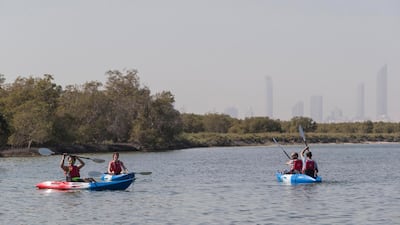After decades of conservation, the mangroves in the UAE have grown to become the largest in the Arabian Gulf coast, according to a new study.
Analysis of satellite images acquired from the King Abdul-Aziz City for Science and Technology recently published in Environmental Monitoring and Assessment show that the UAE is now home to nearly 50 per cent of all mangroves in the region. Moreover, the mangrove coverage in the Emirates has nearly doubled.
"Plantation and rehabilitation projects, primarily in Abu Dhabi, have played an important role in preserving and increasing mangroves throughout the years," Dr Hanan Almahasheer, assistant biology professor at the Imam Abdulrahman Bin Faisal University in Damman wrote in an article published in January called Spatial coverage of mangrove communities in the Arabian Gulf.
It read: “Where they used to cover 40 square kilometres along the UAE coastlines on the Arabian Gulf and one site on the Gulf of Oman coast, at Khor Kalba, now they are extensively found along UAE coastlines with about 79 square kilometres, comprising 48 per cent of the overall mangroves in the region.”
The images were captured last year using the Landsat 8 observation satellite; however, since the satellite only registers images at a spatial resolution of 30 metres or higher – meaning that any mangrove clusters smaller than 30 meters would not be visible – the actual area covered by mangroves is likely to be much higher.
The Environment Agency Abu Dhabi, which maps the emirate’s mangroves using higher-resolution satellites, estimates the coverage to be closer to 155 square kilometres, said Dr Himansu Sekhar Das, unit head of marine threatened species for the EAD.
“We don’t blame them for not detecting that. It is because they are using satellite data with a different resolution,” Dr Das said after reviewing the report.
Dr Das said the growth of the UAE mangroves was due to a plantation program undertaken by the Abu Dhabi Government initiated decades ago by the Founding Father, Sheikh Zayed.
“It has almost doubled in 20 or 30 years,” Dr Das said. “What you see today is the result of 40 years’ worth of planting between the natural mangroves. During a period where we are losing mangroves in many parts of the world, here they are doing well. Due to political will and government interest, we are able to maintain this habitat and this is part of our mandate.”
The extensive planting program had been so successful that the EAD no longer plants mangroves in new areas where they didn’t previously exist.
“We don’t have much space left for mangrove plantation,” said Dr Das, noting that the remaining areas of potential new growth belong to existing ecosystems that could be negatively impacted with the introduction of mangroves. “You can’t encroach another habitat just to increase mangrove cover. What we are doing, we are limiting our efforts to lost and degraded mangrove areas.”
Other countries in the region have not been as successful or committed to protecting their mangroves, according to the report.
____________
Read more:
Tens of thousands of mangroves to be planted across the UAE
Marine conservation group launches in Middle East
Sharks become victims of most deadly predator in the Gulf - overfishing
____________
“Unfortunately, population pressures on the coast led to major losses in some areas of this region,” Dr Almahasheer wrote in her report.
Of the 165 square kilometres of mangroves scattered across the Gulf, the UAE contained the largest portion, with 78.7 square kilometres, followed by Iran, 65.2 square kilometres; Saudi Arabia with 10.3 square kilometres; Qatar, 9.9 square kilometres; Kuwait, 0.58 square kilometres; and Bahrain, 0.58 square kilometres.
Iran contained the highest number of mangrove communities or small clusters of mangrove trees, with 3,403, while the UAE had 2,846; Qatar, 392; Saudi Arabia, 316; Kuwait, 44; and Bahrain, 28.
“It is necessary to minimise stress on mangroves,” Dr Almahasheer wrote, noting erosion, pollution and urban development continue to be the greatest threats.

